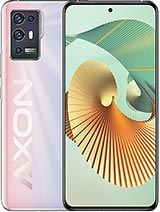Worlds FIRST Under Display Camera?! - Durability Test! By JerryRigEverything
Today we have something super interesting: the world's first under display camera, right here on the Axon 20 5G... or is the 07 Noxv? So many new phones these days, and if you understood that reference you've probably been subscribed for too long. Right out of the box this thing looks pretty beastly, like some kind of super villain phone. I can see this hiding in Voldemort's pocket, or Darth Vader using it to play some Flappy Birds after blowing up Alderaan. I kind of like it. Let's get started.
Inside the box we get our normal wall charger, USB-C power cord, and a free case. Protection is always a good thing. But seriously, this back is insane. I bet for sure this is how Sauron calls his mom. The coolest part of this phone though, and what we are here for is the front camera.
The Axon 20 has a wall to wall bezel less display, no notch, and no motorized pop up camera. It still has a front facing camera hidden here somewhere. If I pull down the menu a little bit we can see that indeed the screen is notchless. But when I open up the camera it can still take my picture. Kind of mind blowing.
The image quality is unique. Remember, this is a $450 smartphone, and all my lights have halos around them. But if I pull the camera back and take a normal selfie, it's not that bad. It's not as clean or crisp as the regular surface mounted camera, but remember, we are taking a picture through the screen and this is a first generation unit, so it's probably not going to be completely perfect. Side by side with my Note 10 Plus, we can see the quality difference.
Remember though that the Axon 20 is half the price. The front camera is 32 megapixels which is quite a bit more pixels than we're used to seeing. And might be because the camera just needs more data to work with since it's capturing an image through so many screen layers. All of the stock backgrounds on the Axon 20 have a dark patch on the top of the screen, so I'm going to take my own picture with a white background so we can get a close up look at that see through display in action. If you remember, last year in the before times, I went and saw a transparent OLED TV made by LG, where when the pixels turn on they illuminate.
But when they go black, they turn off and they are just gone. And it's transparent because the area around the pixels is clear. And if we look really closely we can see that ZTE is kind of doing the same thing, but has accomplished their transparency by actually using two different screens. The main screen takes up most of the phone's real estate, but there is a smaller, second lower resolution screen about the size of an ant that covers up the camera. And since it's lower resolution in this one tiny spot, it gives the camera more room between pixels to see through.
But only when the display is black and the pixels are turned off. You can see the cool little screen effect that plays when I turn the front facing camera on, and how the camera can see through the glass screen when the OLED pixels are black or turned off. If the pixels were lit the camera behind the glass would obviously not work. Pretty fascinating and I think it works pretty well for a first generation device. I mean, if you're a professional Snapchatter or TicToker, this might not be the best camera for you.
But for a sub $500 phone shooting through the screen, I think it's pretty darn good. The square patch is semi obvious when we're zoomed in up close in 4K resolution. But if we back up to a normal perspective it does disappear and blend into the rest of the screen pretty well. When we're watching a full screen video, that ant sized patch of low resolution OLED pixels are basically unnoticeable. They are working just as hard as their higher resolution counterparts on the rest of the screen.
And if I'm being honest, I kind of like this transparent display better than a notch or a hole punch. I'm a fan of where this technology is headed. We'll get back to the front camera more in just a second, but first let's see what the rest of the Axon 20 is made of. For a $450 phone, I've been impressed so far. Just like usual we use the Mohs scale of hardness to check the screen.
And, just like usual, we start seeing scratches at a level 6, with deeper groves at a level 7. ZTE has made everything go under the display this time around, including the earpiece. We've seen underscreen earpiece technology before, like in the Pixel 5, but it is pretty cool to see one brand implementing all of the underscreen technologies in one phone. Up close and personal again with that camera square, at some angles it stands out more than others. And if we hold it just right, we can almost see the camera unit itself behind the glass.
Still protected from scratching, of course. The sides of the Axon 20 5G are made from plastic, along with the top of the phone. No headphone jack here. And there is more plastic running down the other side. Once we get to the bottom of the phone there is more plastic yet again.
There is nothing wrong with plastic of course, but it does make you wonder how it will hold up during the bend test. There is a SIM and SD card slot, but no official IP rating. Flipping the phone over you can see once again that this is totally a phone Loki would call an Uber with – evil, yet stylish. The Noxv logo on the bottom corner is covered with glass, along with the 4 unit camera lens. The 2 megapixel macro camera down at the bottom, then a 2 megapixel depth camera, 64 megapixel main camera, and finally an 8 megapixel wide angle camera up top with it's single color dual LED flash.
Speaking of putting everything beneath the screen, the Axon 20 has an optical underscreen fingerprint scanner. Once I get that all good and scratched up at level 7 deeper grooves, it can still read and unlock my fingerprint every single time. Thumbs up for that. I think we should get one more close up look at this inside second screen, just in case this is our last chance since not every phone survives the bend test. It's mostly invisible when looking at the phone head on.
But at certain angles in super bright light, we can peer into its depths. Fire is also sometimes associated with evil, which is perfect because I do happen to have some fire. The 6.9 inch 1080p display on the Axon 20 is 10 bit, which means it has way more colors than your average iPhone or Samsung. And it lasts about 13 seconds under the heat from my lighter, but still mostly recovers. And since I know some of you want to know what happens when I burn the baby screen up top, we'll go ahead and try that as well.
It is an evil phone. After about 10 seconds we get the same pulsing lights, and even though it does recover, that burn makes the secondary screen a bit more visible. So it might be a good idea to leave the villain phone top side if you're ever visiting Hades in the underworld. Finally, the bend test. The Axon 20 is a large phone with plastic sides, and does flex a bit with the bend test, but does not crack or break, even when bent from the opposite direction.
Not too shabby. The Axon 20 5G passes my durability test. I'm curious, would you rather have an underscreen camera, or a notch on your next phone? Let me know down in the comments. Either way, I think it's a safe bet that we're going to see a lot more of this underscreen camera stuff in the future. It'll probably show up in some sketchy products as well as Apple being very excited when they invent it in 3 or 4 years.
But I look forward to that. Hit that subscribe button so you don't miss the teardown. We're going to see that camera from the inside. And come hang out with me on Instagram and Twitter. Thanks a ton for watching.
I'll see you around.
Source : JerryRigEverything



























